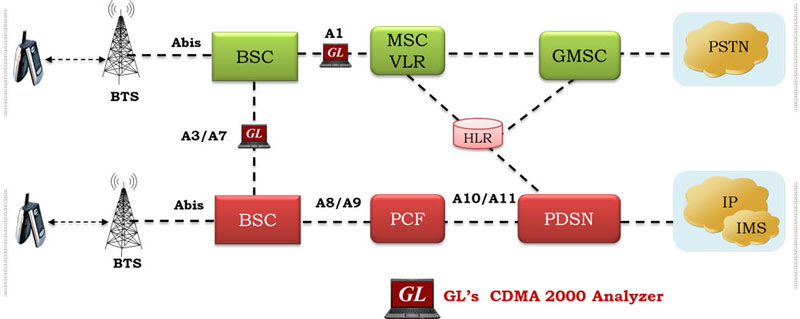Newsletter: GL Releases CDMA 2000 Protocol Analyzer
Welcome to the October issue of GL's Newsletter providing information and insight into our latest product, CDMA Protocol Analyzer software for Ultra T1/E1 PCI bus cards, Portable T1/E1 analyzers, as well as Ethernet interfaces.
The transition to 3G networks will deliver improved system capacity and system efficiency in comparison to 2G systems. To deliver both voice as well as broadband data, CDMA networks have incorporated many structural enhancements to the 2G CDMA networks (also called CDMA-One, and ITU-IS-95). The latest 3G technology, called CDMA 2000 1xEV-DO is capable of delivering integrated voice and simultaneous multimedia services at peak data rates of 3.09 Mbps to the end subscriber.
IS-2000 is the signaling standard, which defines protocols for several critical 3G CDMA interfaces pertaining to packet transmission namely A1, A7, A9 and A11 (shown below). An IS-2000 compliant Mobile Station (MS) can select either packet-switched data (PSD) or circuit-switched data (CSD) transport. CSD has maximum rate of 19.2 kbps and is delivered over traditional TDM circuits. PSD offers higher data rate for multimedia services. For each data session, a PPP (Point-to-Point Protocol) session is created between the Mobile Station and the Packet Data Serving Node (PDSN). Some of the major interfaces are shown below:

The CDMA2000 network comprises of the Radio Access Network (RAN) and the Core Network. A Mobile Station accesses the CDMA2000 network through the RAN. The RAN consists of the Air Link, Base Station Transceiver Subsystem (BTS), Base Station Controller (BSC), and a part of Packet Control Function (PCF). The RAN maps the Mobile Station ID to a unique link layer identifier that is used to communicate with the PDSN, validate the MS for access service, and maintain the established transmission links. The BTS connects to the BSC through un-channelized T1s and A-bis protocols ( proprietary to a particular vendor) based on HDLC.
The BSC routes PSD and CSD messages between the cell sites and the MSC. In addition, the BSC is also responsible for mobility management. It connects to each Mobile Telephone Exchange (MTX) using channelized T1 lines for voice and circuit switched data; and to un-channelized T1 lines for signaling and control messages to the PDSN using Ethernet protocols.
The PCF routes IP data packets between the MS and the PDSN. The PDSN is the Gateway from the RAN into the public and private networks. The PDSN can act as either a standalone Network Access Server (NAS), Home Agent (HA) or a Foreign Agent (FA).
GL's CDMA Protocol Analyzer can be used to analyze and view protocols across A1 (between Base Station Controller and Mobile Switching Center), A3 and A7 (between two Base Station Controllers), A9 (between Base Station Controller and Packet Control Function), and A11 (between Packet Control Function and PDSN) signaling interfaces as depicted in the above figure.
Supported Protocols
IOS* Application for A1 (3GPP2 A.S0014-A, Version 2.0.1, Date: July 2003): The A1 interface is the interface between BSC and MSC (Mobile Switching Center) for the circuit-switched side of CDMA2000 network, which is basically an HDLC based network that carries MTP2, MTP3, SCCP, BSSAP and DTAP protocols. GL's CDMA A1 interface supports ITU-T and ANSI Standard Interfaces.
IOS Application for A3 and A7 (3GPP2 A.S0015-C, Version 1,0 Date: February 2005): The A7 interface carries signaling information between a source Base Station(BS)** and a target Base Station. The specified IOS application describes about inter-BS soft handoff procedures. The A3 interface carries coded user information (voice/data) and signaling information between the source BS Selection/Distribution Unit(SDU) function and the channel element component (BTS) of the target BS. These interfaces are provided using ATM cells over T1/E1 and SONET transmission links.
IOS Application forA9 and A11 (3GPP2 A.S0016-C, Version 1,0 Date:F ebruary 2005 & 3GPP2 A.S0017-A,Version 2.0.1, Date: July 2003): The A9 interface carries signaling information between the BSC and the PCF, where as, A11 interface carries signaling information between the PCF and PDSN. These IP based interfaces use Ethernet protocols.
* Inter-Operability Specification
** Base Station (BS) is an entity in the public radio telecommunications system used for radio telecommunications with mobile stations; Base Transceiver Station (BTS) is a channel element component of a base station that includes radio equipment, while, Base Station Controller (BSC) is the control portion of the base station that includes call control logic and interconnections to the MSC.
Analysis Features
- Compatible with Windows 2000/XP/Vista Operating Systems with user friendly GUI. Works with GL's field proven Ultra E1 or T1 internal cards or Laptop E1 or T1 external units. Offline and Remote applications are also available with separate licenses.
- Supports analysis in real-time as well as offline.
- Supports capturing and decoding of Ethernet-based protocols (across Aquinter and Aquater interfaces), ATM based protocols (across Ater interface), & HDLC based protocols (across A interface).
- Allows customized filtering/searching of the captured data (real-time/offline) by setting various parameters such as VPI/VCI, Payload Type, MAC layer address, Frame length, IP address, Port number and so on based on the interfaces chosen.
- Supports ATM Direct mapping and Scrambling options while capturing across A3 & A7 interface.
- Data transmission rate starting from 8kbps to N x 64kbps is supported in CDMA A1 analyzer. Timeslots selection for CDMA (A1, A3, A11) analyzers can be contiguous or non-contiguous.
- Allows exporting summary and detail view information to a comma-delimited file for subsequent import into a database or spreadsheet.
- Supports call trace view for called/ calling number, released calls, call status, etc, and statistics display based on frame count, byte count, frames/sec, bytes/sec, and more for the entire capture data.
Network Surveillance
Call records and message trace can be monitored remotely and centrally using NetSurveyor™. Central monitoring features include:
- Ability to view CDR and Message Trace data in real-time from anywhere in the world using the Internet
- Ability to sort and filter protocol data.
Please visit CDMA 2000 Protocol Analyzer web link for further details.
 Back to Latest News Page
Back to Latest News Page